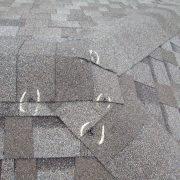Common Causes of Roof Leaks and How to Identify Them
A leaking roof can quickly turn from a minor annoyance into a major home repair issue. Understanding the common causes of roof leaks can help homeowners identify and address problems before they lead to extensive damage. From weather-related issues to unexpected animal visitors, numerous factors can compromise your roof’s integrity.
Damaged or Missing Shingles
Strong winds, severe weather including hail damage, and general aging can damage or completely remove roof shingles. When shingles are compromised, water can penetrate the underlying roofing structure. You might notice curled or buckled shingles, dark patches where granules have worn away, or find fragments of shingles in your yard after storms. These visible gaps in your roof’s surface are clear indicators that repairs are needed.
Faulty Flashing
Flashing is the metal material installed around chimneys, vents, skylights, and other roof penetrations. This critical component often fails due to natural weathering, leading to some of the most common roof leaks. Over time, metal flashing can corrode or rust, seams can separate, and joints can lose their seal. Even a small gap in flashing around a vent pipe or chimney can allow significant water infiltration during heavy rain.
Animal Damage
Wildlife, particularly squirrels and other rodents, can cause substantial damage to your roof. These resourceful creatures often gnaw through wooden components, tear up shingles, and create entry points into your attic. Squirrels are especially problematic as they can chew through various roofing materials to create nests. Once they’ve established an entry point, they may continue to expand their access, leading to larger holes and more severe leaks. Birds can also contribute to roof damage by building nests that block water drainage and hold moisture against the roof surface.
Skylight Problems
While skylights add beautiful natural light to your home, they’re also frequent sources of leaks. The complexity of skylight installation makes them particularly vulnerable to water infiltration. Problems typically stem from deteriorated seals around the frame, improper installation angles that prevent proper drainage, or cracked glass. Many homeowners mistake natural condensation buildup for skylight leaks, though both issues require attention to prevent water damage.
Tree Damage
Trees overhanging your roof pose multiple threats to its integrity. Beyond the obvious risk of falling branches puncturing the roof surface, constant rubbing from branches can gradually wear down shingles. Leaves and small twigs accumulate in valleys and gutters, holding moisture against the roof and potentially leading to rot. Even trees that don’t directly touch your roof can cause problems, as their root systems may affect your home’s foundation, leading to subtle shifts that stress roofing materials.
Age-Related Deterioration
Most roofing materials have a limited lifespan, and age-related deterioration is inevitable. As your roof ages, it becomes more susceptible to leaks through general material breakdown, UV radiation damage, and repeated freeze-thaw cycles. The waterproofing properties of roofing materials gradually diminish, making regular inspection and maintenance increasingly important as your roof gets older.
Valley Issues
Roof valleys, where two roof slopes meet, require special attention as these areas channel large amounts of water during rain. Proper valley construction includes specialized flashing and underlayment to handle this concentrated water flow. When these components fail, either through improper installation or wear over time, leaks can develop rapidly. Winter presents additional challenges as valleys are prone to ice dam formation, which can force water under shingles and into your home.
Prevention and Maintenance
The key to avoiding costly roof repairs lies in regular maintenance and prompt attention to minor issues. Annual professional inspections can catch problems before they become severe. Keep your gutters clean and flowing freely, as backed-up gutters can force water under shingles and into your home. If you have trees near your house, regular trimming can prevent branch damage and reduce leaf accumulation. Address any signs of animal activity quickly, as small entry points can rapidly become larger problems.
When you notice signs of a roof leak, immediate action is crucial. Water damage extends beyond the roof, potentially affecting ceilings, walls, insulation, and even your home’s foundation. Working with a qualified roofing professional ensures repairs are completed correctly and helps prevent future issues. Remember that the most cost-effective approach to roof leaks is prevention – addressing potential problems before they allow water into your home can save thousands in repairs down the line.
If you notice any of the problems mentioned above, reach out to 1st Choice Construction and we’ll provide a free estimate for the repair.












